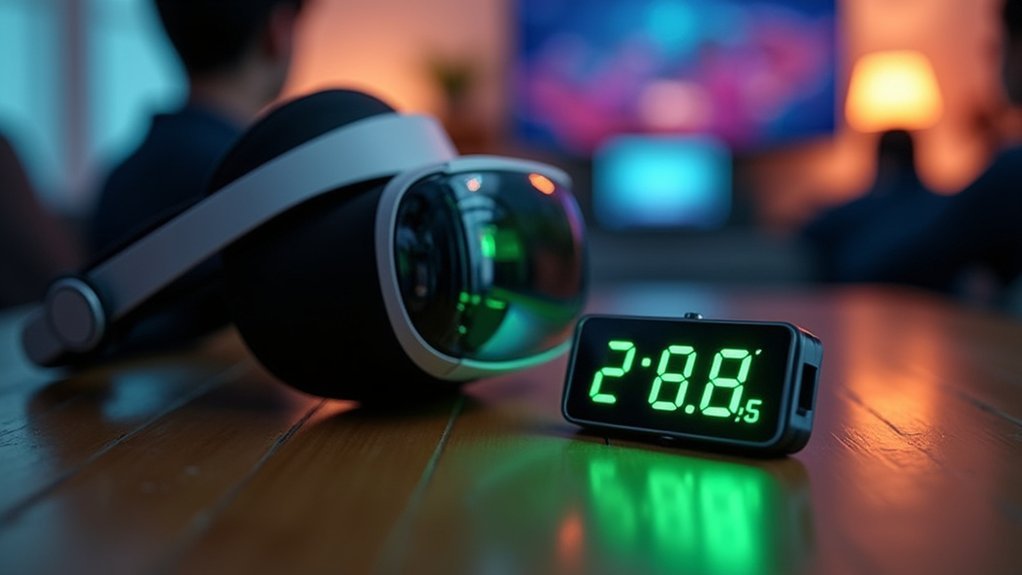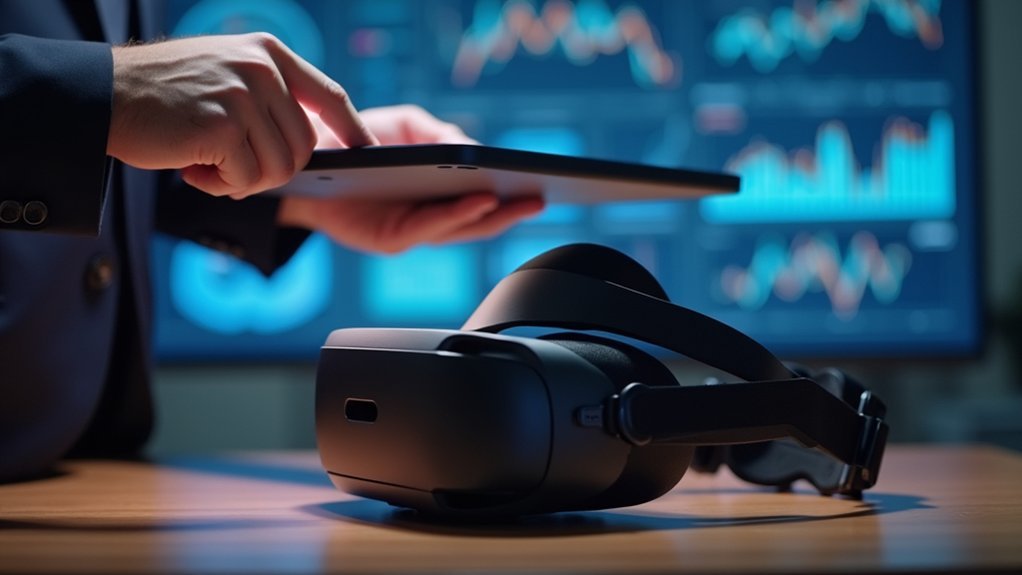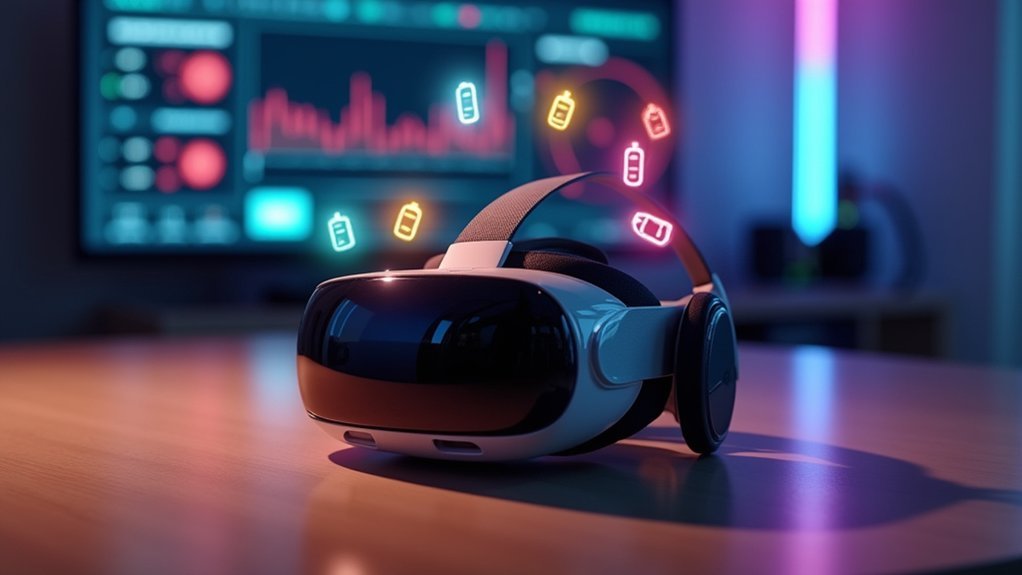You need to monitor your VR headset’s battery health because degraded batteries cause sudden shutdowns during immersive sessions, leading to disorientation and frustration. Poor battery health reduces your gaming time from 2-3 hours to markedly less, while also causing frame drops and visual quality issues. Heat accelerates degradation above 25°C, potentially damaging expensive hardware. Proactive monitoring can extend battery lifespan by 30% and reduce maintenance costs by 25%, ensuring reliable performance when you discover the full scope of optimization strategies.
Understanding Battery Degradation in VR Headsets

When you use your VR headset regularly, its lithium-ion battery gradually loses capacity through a natural process called degradation.
This battery degradation typically results in about 20% capacity loss after 300-500 charge cycles, depending on how you use and charge your device. You’ll notice shorter gaming sessions, reduced performance, and more frequent charging needs as degradation progresses.
Heat accelerates this process considerably. When your headset operates above the ideal 20°C to 25°C range, you’re speeding up battery degradation.
After two to three years of typical use, you’ll likely experience a considerable capacity drop that affects your VR experience. Understanding this degradation helps you recognize when it’s time for battery replacement and enhance your charging habits to extend battery life.
Impact of Battery Health on VR Performance
Poor battery health directly compromises your VR performance in ways that extend far beyond shorter play sessions. When your headset’s battery degrades, you’ll experience unexpected shutdowns during vital gaming moments, reduced visual fidelity, and performance throttling that breaks immersion.
| Battery Condition | Runtime Impact | Performance Effect |
|---|---|---|
| Healthy Battery | 2-3 hours full session | Ideal visual quality |
| Degraded Battery | Notably reduced time | Throttled performance |
| Critical Battery Health | Frequent shutdowns | Poor visual fidelity |
You’ll notice frame drops and stuttering as your device struggles with insufficient power delivery. Temperature fluctuations from poor battery health cause additional performance issues, making monitoring essential. Advanced AI-powered battery management systems can extend lifespan by 30%, maintaining consistent performance. Regular capacity monitoring prevents these disruptions.
Preventing Sudden Power Loss During Immersive Sessions

You’ll need to recognize battery degradation warning signs like rapid drain rates exceeding 1% per minute or unusual heating patterns that signal imminent power failure.
Real-time power monitoring through integrated sensors gives you precise battery status updates, allowing you to anticipate when your VR session might be interrupted.
Emergency shutdown prevention systems can automatically trigger low-power modes or provide advance warnings, ensuring you won’t lose progress during critical moments in your immersive experience.
Battery Degradation Warning Signs
The most telling sign of battery degradation appears when your VR headset’s usage time drops considerably below its expected 2-hour baseline.
These battery degradation warning signs indicate your device needs attention before it compromises your immersive experiences.
Watch for these critical indicators:
- Rapid percentage drops – Your battery meter plummets from 80% to 40% within minutes of starting a session
- Overheating episodes – The headset becomes uncomfortably warm during normal gameplay, causing performance throttling
- Inconsistent power readings – Battery levels jump erratically or show full charge one moment, then critical low the next
When you notice these symptoms, it’s time to reflect on battery replacement or professional servicing.
Don’t wait until complete failure ruins your virtual adventures.
Real-Time Power Monitoring
Proactive monitoring prevents the jarring experience of your VR headset dying mid-session when you’re deep in an intense gaming moment or essential virtual meeting.
Real-time power monitoring systems continuously track your battery levels and alert you before reaching critical thresholds, ensuring uninterrupted immersive experiences.
Advanced battery management systems now use AI to predict your device’s power consumption patterns, optimizing performance while extending usage times.
You’ll receive timely notifications that let you plan charging breaks or adjust settings to conserve energy.
This monitoring also tracks temperature variations, preventing overheating during extended sessions.
Emergency Shutdown Prevention
When your VR headset suddenly dies during an intense gaming session or essential virtual meeting, you’re not just facing inconvenience—you’re risking disorientation, potential injury, and possible hardware damage.
Monitoring battery health prevents these emergency shutdowns by providing critical early warnings before power levels reach dangerous thresholds.
Effective emergency shutdown prevention through battery health monitoring creates these protective scenarios:
- The Warning Zone: You receive alerts when battery drops to 20%, giving you time to save progress and safely exit your virtual environment.
- The Grace Period: Smart power management extends remaining battery life during critical moments, preventing mid-experience crashes.
- The Safe Landing: Controlled shutdown sequences protect your data and hardware when power becomes critically low.
You’ll maintain longer, safer VR sessions while protecting your expensive equipment from sudden power-related damage.
Extending Device Lifespan Through Proactive Monitoring

You can greatly extend your VR device’s lifespan by implementing early warning systems that alert you to battery degradation before critical failures occur.
These systems monitor key parameters like voltage drops and temperature spikes, giving you advance notice when it’s time for preventive maintenance.
Early Warning Systems
As VR technology advances, early warning systems have emerged as vital components that monitor your device’s battery health in real-time, preventing costly failures before they occur.
These AI-driven systems continuously assess essential parameters like temperature and voltage, enabling proactive identification of potential issues.
Your VR device’s early warning systems provide three key protective measures:
- Temperature alerts – Notifications when your battery reaches dangerous heat levels that could cause permanent damage
- Voltage irregularity detection – Real-time monitoring that catches power fluctuations before they trigger unexpected shutdowns
- Predictive failure warnings – Advanced analytics that forecast battery degradation up to 30% sooner than traditional methods
This proactive approach transforms battery health management from reactive repairs to preventive care, ensuring your VR experiences remain uninterrupted while maximizing your investment’s longevity.
Preventive Maintenance Strategies
Building on these early warning capabilities, smart preventive maintenance strategies transform how you care for your VR device’s battery system.
You’ll implement regular health checks and temperature monitoring that can improve battery life by approximately 30%. These proactive approaches identify overheating or rapid discharge patterns before they cause irreversible damage.
You can reduce battery replacement costs by up to 25% through timely interventions. AI-driven analytics optimize your charging cycles and usage patterns, extending your VR headset’s operational life considerably.
Real-Time Battery Status Indicators and Alerts
When you’re deep in a virtual world, nothing disrupts immersion quite like an unexpected headset shutdown. Real-time battery status indicators solve this problem by providing immediate feedback on your device’s power levels, ensuring uninterrupted VR sessions.
Modern VR headsets employ sophisticated alert systems to maintain peak battery health:
- Visual dashboard overlays that display remaining charge percentage directly in your field of view.
- Auditory warning chimes that activate when battery levels drop below critical thresholds.
- Temperature monitoring displays that prevent overheating through color-coded alerts.
These systems notify you well in advance of power depletion, giving you time to recharge or swap batteries.
Advanced management features analyze your usage patterns and predict battery lifespan, helping you enhance charging habits for peak performance and device longevity.
Temperature Management in High-Performance VR Systems
While battery indicators keep you informed about power levels, temperature management forms the backbone of sustained VR performance. When temperatures exceed 70°C, you’ll experience thermal throttling that degrades battery efficiency and overall system performance.
Your VR headset uses advanced cooling solutions like active ventilation and heat dissipation materials to maintain ideal operating conditions. Real-time temperature sensors provide dynamic data, allowing automatic performance adjustments that prevent overheating during extended sessions.
| Temperature Range | Performance Impact | Battery Efficiency | System Response |
|---|---|---|---|
| 20°C – 30°C | Ideal | Maximum | Normal operation |
| 31°C – 50°C | Good | Reduced | Minor adjustments |
| 51°C – 70°C | Declining | Poor | Performance limiting |
| Above 70°C | Throttled | Severely degraded | Emergency cooling |
Maintaining temperatures between 20°C to 30°C ensures your hardware’s longevity while supporting peak performance and user comfort.
Optimizing Power Consumption for Extended Play Sessions
You’ll maximize your VR play sessions by finding the right balance between visual quality and power efficiency through careful graphics settings adjustment.
Managing your headset’s battery temperature prevents thermal throttling that can drain power faster and reduce performance during extended gaming.
These two optimization strategies work together to guarantee you’re getting the most runtime possible from each charge cycle.
Graphics Settings Balance
Fine-tuning your VR graphics settings represents one of the most effective ways to extend battery life without sacrificing your entire gaming experience.
You’ll discover that strategic adjustments can dramatically impact your battery level while maintaining visual quality. Tools like SteamVR and Oculus Debug Tool let you customize supersampling and other parameters. Lowering resolution doesn’t mean compromising fun—it means playing longer.
Close unnecessary background applications that drain resources silently.
Consider these optimization strategies:
- The Detective Approach: Monitor your battery level while testing different graphics presets, noting which settings provide the sweet spot between performance and longevity.
- The Minimalist Setup: Strip graphics down to essentials, keeping only visual elements that enhance gameplay.
- The Smart Scheduler: Adjust settings based on planned session length—higher quality for short bursts, optimized settings for marathon sessions.
Battery Temperature Management
Smart graphics optimization extends beyond visual settings—your battery’s temperature directly impacts performance and longevity during those marathon VR sessions you’ve been planning.
Effective battery temperature management keeps your headset operating within the ideal 20°C to 30°C range, preventing performance throttling and unexpected shutdowns.
You’ll want to implement thermal management techniques like heat sinks or active cooling systems for extended play. Adaptive display technologies can reduce power consumption by 24% while minimizing heat generation.
Your headset’s built-in monitoring systems track temperature fluctuations and alert you before overheating occurs.
Regular temperature checks and software optimizations prevent safety concerns like thermal runaway. By maintaining proper battery temperature management, you’ll extend usage time and protect your investment from heat-related degradation.
Identifying Early Warning Signs of Battery Failure
While your VR headset might seem to be functioning normally, several telltale signs can indicate impending battery failure long before complete power loss occurs.
You’ll want to monitor these key indicators to prevent sudden shutdowns during gameplay.
- Temperature spikes – Your battery feels unusually warm during charging or use, signaling internal degradation that could lead to dangerous overheating.
- Voltage inconsistencies – You notice reduced usage time despite full charges, indicating your battery’s capacity is declining and can’t hold its original power levels.
- Charging anomalies – Your device takes considerably longer to reach full charge or stops charging at lower percentages, revealing deteriorating battery efficiency.
Tracking these warning signs helps you address issues proactively.
Wireless VR Headset Battery Challenges
Because wireless VR headsets operate without tethered power sources, they face unique battery challenges that can dramatically impact your gaming experience.
You’ll typically encounter drain rates of approximately 1% per minute, limiting your sessions to roughly two hours on a full charge. Battery performance deteriorates further when you increase display brightness, boost volume settings, or enable features like hand tracking and Air Link connectivity.
Despite manufacturers’ battery saver options, you’ll still face frustratingly short usage durations that interrupt immersive experiences.
The underlying battery technology hasn’t fundamentally improved in newer headsets, meaning efficiency and lifespan limitations persist.
You’ll likely need accessory solutions like the Meta Quest 3 Elite Strap with Battery to achieve extended untethered sessions and maintain consistent battery performance.
Data-Driven Approaches to Battery Health Assessment
Modern VR headsets now incorporate sophisticated sensors that continuously collect voltage, current, and temperature data to provide real-time insights into your battery’s actual condition.
These data-driven approaches leverage advanced machine learning techniques, particularly LSTM neural networks, to analyze multidimensional time series data and deliver accurate state of health estimations.
You’ll benefit from three key improvements:
- Proactive maintenance alerts that notify you before battery degradation affects your gaming sessions
- Extended battery lifespan through optimized charging patterns based on usage data
- Reduced downtime with predictive analytics that schedule maintenance during off-peak hours
Cost Benefits of Preventive Battery Maintenance
Since neglected batteries often fail at the worst possible moments, investing in preventive battery maintenance for your VR headset’s power system delivers substantial financial returns.
You’ll reduce overall maintenance costs by up to 25% while extending battery lifespan by an average of 30%. This translates to fewer costly emergency repairs and replacements that can interrupt your VR sessions.
Preventive battery maintenance creates a structured monitoring system that decreases downtime and improves your device’s reliability.
You’ll avoid unexpected failures during critical gaming moments or professional presentations. AI-driven monitoring optimizes energy usage, lowering operational costs associated with frequent battery replacements and power consumption.
Additionally, you’re contributing to environmental sustainability by reducing waste and battery disposal frequency, supporting a circular economy while protecting your wallet.
User Experience Enhancement Through Reliable Power
You’ll achieve an uninterrupted VR experience when reliable power management prevents your headset from shutting down unexpectedly during critical moments.
Your immersive sessions can extend considerably longer, allowing you to fully engage with virtual worlds without constant battery anxiety.
Consistent power delivery guarantees your display maintains ideal brightness and refresh rates, keeping you completely absorbed in the virtual environment.
Preventing Unexpected Device Shutdowns
When your VR headset suddenly powers down mid-session, it doesn’t just interrupt your experience—it can cause disorientation and frustration that ruins hours of progress.
With VR devices consuming battery at approximately 1% per minute during active use, monitoring battery health becomes essential for uninterrupted gameplay.
Effective battery health monitoring prevents these jarring shutdowns through:
- Real-time awareness – You’ll know exactly when your 2-3 hour battery window is approaching its end.
- Proactive charging opportunities – You can plan recharge breaks before reaching critically low levels.
- Power optimization settings – You’ll adjust performance modes to extend usage time when needed.
Extending Immersive Session Duration
Beyond preventing shutdowns, strategic battery health monitoring transforms your VR experience by extending session duration through intelligent power management.
When you monitor battery health actively, you’ll optimize power consumption patterns that typically limit VR headsets to 2-3 hours of usage. Advanced battery management systems can increase your battery lifespan by up to 30%, directly translating to longer uninterrupted sessions.
Real-time monitoring provides predictive analytics that alert you before depletion occurs, allowing you to plan extended gaming or training sessions confidently.
You’ll receive timely notifications about power status, enabling strategic breaks or charging opportunities. This proactive approach guarantees you’re maximizing every minute of your immersive experience, whether you’re exploring virtual worlds, attending meetings, or engaging in educational content without constantly worrying about remaining power levels.
Maintaining Consistent Display Performance
Although battery degradation might seem like a gradual concern, it directly impacts your VR display’s consistency and can create jarring visual disruptions that shatter immersion.
When your battery health deteriorates, power fluctuations cause screen flickering, dimming, and visual artifacts that pull you out of virtual worlds.
Real-time monitoring helps you manage power consumption effectively, optimizing graphics settings to balance performance with battery longevity.
You’ll maintain stable visual quality throughout your session without compromising the experience.
Key signs your VR display suffers from poor battery health:
- Sudden brightness drops during intense gaming sequences, making dark environments nearly invisible
- Intermittent screen flickering that creates strobing effects during fast-paced action scenes
- Color distortions where vibrant virtual landscapes appear washed out or oversaturated
Advanced monitoring systems predict performance issues, enabling proactive adjustments before problems disrupt your immersive experience.
Advanced Monitoring Technologies for VR Devices
Advanced monitoring technologies for VR devices have revolutionized how you can track and maintain your headset’s battery health. These AI-driven systems continuously monitor critical parameters like temperature, voltage, and current, ensuring peak performance and safety during your VR sessions.
You’ll benefit from predictive analytics that identify potential battery issues before they occur, greatly extending your headset’s lifespan and usability.
IoT integration enables real-time data collection from multiple embedded sensors, providing efficient analysis and timely maintenance alerts.
Machine learning algorithms enhance battery health predictions by analyzing vast datasets, delivering more accurate assessments and proactive performance management.
With continuous monitoring, you can reduce maintenance costs by up to 25% and increase battery lifespan by 30%, making your VR experience more economical and sustainable.
Future Developments in VR Battery Health Systems
The next generation of VR battery health systems will transform how you monitor and maintain your headset’s power source.
AI-driven monitoring will revolutionize how you track battery performance, using machine learning algorithms to analyze sensor data and predict potential issues before they occur. You’ll benefit from real-time identification of battery problems and extended device lifespan through intelligent maintenance scheduling.
Three key innovations will reshape your VR experience:
- Gaze-contingent shaders that reduce display power consumption by 24% while maintaining visual quality
- IoT connectivity providing continuous battery status updates and performance metrics to your devices
- Standardized protocols ensuring seamless integration across different manufacturers and AI technologies
These collaborative manufacturer efforts will streamline battery management, reducing maintenance costs while enhancing your overall VR experience.
Frequently Asked Questions
What Are the Health Issues With Virtual Reality?
You’ll experience eye strain, headaches, and motion sickness from VR use. Prolonged sessions can cause neck pain, balance issues, and social isolation. You might develop dependency, sleep disruption, and anxiety from intense virtual experiences.
How Long Should VR Battery Last?
You should expect your VR headset’s battery to last 2-3 hours on a full charge. However, demanding apps can drain it faster, reducing usage to about 90 minutes depending on your settings.
How Can I Make My VR Battery Last Longer?
You can extend your VR battery life by lowering graphics settings, closing background apps, reducing brightness, monitoring temperature, and using power-saving modes or external battery packs for longer sessions.
Is VR Safe for Your Brain?
VR’s generally safe for your brain when used moderately. You might experience eye strain, headaches, or cybersickness affecting up to 40% of users. Limit sessions and take breaks to minimize potential disorientation and balance issues.





Leave a Reply